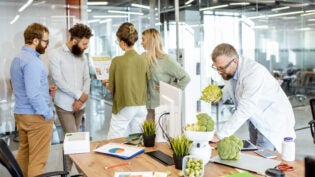
In times of crisis, true leadership is tested. Whether it’s adapting to unexpected changes, managing rapid growth, or dealing with the loss of a key client, how a leader responds during critical moments can determine the future of their business. Effective leaders remain calm, strategic, and adaptable, ensuring their organizations not only survive but thrive. The following stories highlight business leaders who exemplified leadership during a crisis, showing resilience in the face of uncertainty. Their experiences offer valuable lessons in navigating unexpected hurdles while driving sustainable growth.
1. Adapting to Algorithm Changes for Growth
A significant challenge that we faced was in early 2018 when a major algorithm update by Google hampered our search engine visibility, plummeting our web traffic dramatically. As a platform relying heavily on search engine traffic, this was akin to a direct hit to our key operation. However, instead of bowing down to panic, we approached the situation strategically.
Leveraging my background as a digital marketer, we audited our SEO strategies, optimized the website content, enhanced user experience, and focused on creating more value for our visitors. This rigorous effort paid off, and by mid-2018, not only had we recovered our lost visibility, we saw a significant surge in our organic traffic. This experience taught us the importance of adaptability in the tech world, a lesson that we carry even today.
Nick Drewe, Founder & CEO, Wethrift
2. Balancing Rapid Expansion with Sustainable Growth
Expanding too fast nearly derailed my business early on. Growth isn’t consistent or linear, so extrapolating early results can easily fail you. I knew the boost Bemana experienced early on wasn’t necessarily sustainable, but I still found it difficult to find that balance between striking while the iron was hot and ensuring I wasn’t overly equipped. If I had to do it again, I’d focus more on part-time and fractional workers. This would have provided me with the flexibility I needed in those early years. I also would have pursued remote workers sooner, in order to minimize the office space we required, and invested less in fancy hardware.
I’d advise other companies to embrace an approach to growth that takes into account a wide range of scenarios, from the best to the worst case.
Linn Atiyeh, CEO, Bemana
3. Diversifying Client Portfolio After Dream Client Loss
Not long after launching my recruiting firm, I landed my dream client. This was a company I’d admired for years, and I quickly put everything into the contract, assigning my top workers to the project.
Two months later, the client went under and nearly took my agency with them. I was blindsided, but after doing the due diligence I should have done initially, I realized that I only had myself to blame. I’d been so impressed by their past work in the sector, I had ignored the fact that their latest offering was riddled with problems. They were pushing on, assuming sales would pick up, but if I’d taken a hard look at their numbers, I’d have known that was unlikely, or even impossible. Instead, though, I let my excitement take over.
The loss of income was profound (we never did get paid for the majority of completed work), but I learned a valuable lesson about going in open-eyed and never putting all my eggs in one basket.
Rob Reeves, CEO and President, Redfish Technology
4. Navigating Regulatory Changes with Agile Adaptation
I faced a major challenge when a sudden regulatory shift nearly derailed my entire operation. In my region, new safety standards for outdoor fitness equipment were approved in 2022, and we found ourselves needing to make significant adaptations to our design on short notice to meet updated compliance codes. This unexpected change suddenly put huge threats into both production timelines and cost, putting large projects on hold.
To overcome this, I teamed up with a panel of legal experts and product engineers so that we could re-engineer our equipment without compromising quality or safety. We initiated a compliance audit for all ongoing projects and aligned our supply chain to speed up new certifications. We did not let client trust go cold by maintaining transparent communication.
Rather than endure potential shutdowns, we emerged as leaders in the manufacturing of regulation-compliant, safe fitness equipment, which increased our business by 20 percent for the following year.
Lucas Riphagen, Co-owner, TriActiveUSA
5. Pivoting to Meet Pandemic-Induced Demand
A major obstacle we faced was during the COVID-19 pandemic when a sudden surge in demand for digital loan management solutions coincided with supply chain disruptions affecting our development timelines. Our clients in financial institutions were scrambling to adapt to the new economic realities, and they needed our software faster than ever. Needless to say, we were not equipped to handle this sudden shift in demand.
At the same time, remote work challenges, delays in sourcing key technological components, and increased customer support requests threatened to overwhelm our team. The number of clients waiting to be onboarded was twice as many as we were equipped to handle. This affected our reputation as a week’s wait time turned into a fortnight. We were almost certain our clients were going to pull back their requests.
However, that’s when we decided to pivot as quickly as possible. We restructured our workflows for a fully remote environment and increased our investment in cloud infrastructure. We also expanded our customer success team to handle the influx of new clients while maintaining the high level of service our existing users expected.
The outcome was a stronger, more resilient business. Not only did we meet the increased demand, but we also emerged with a more agile development and support process that continues to serve us well today. This experience reinforced the importance of flexibility and adaptability, which have since become our core values.
Bob Schulte, Founder, Bryt Software LLC
6. Contingency Planning for Supplier Disruption
There was a time when a key supplier unexpectedly went out of business, leaving us without inventory right before a significant sales season. It felt like the business could collapse overnight. Instead of panicking, I focused on solutions. We quickly shifted by diversifying our supplier network and finding alternative sources, even if it meant slightly higher costs initially. We also communicated transparently with our customers about potential delays. The outcome? We managed to fulfill orders on time and, more importantly, learned a valuable lesson about the importance of contingency planning. This experience made the business more resilient.
Chris Putrimas, CEO, Teak Warehouse
792 Views












